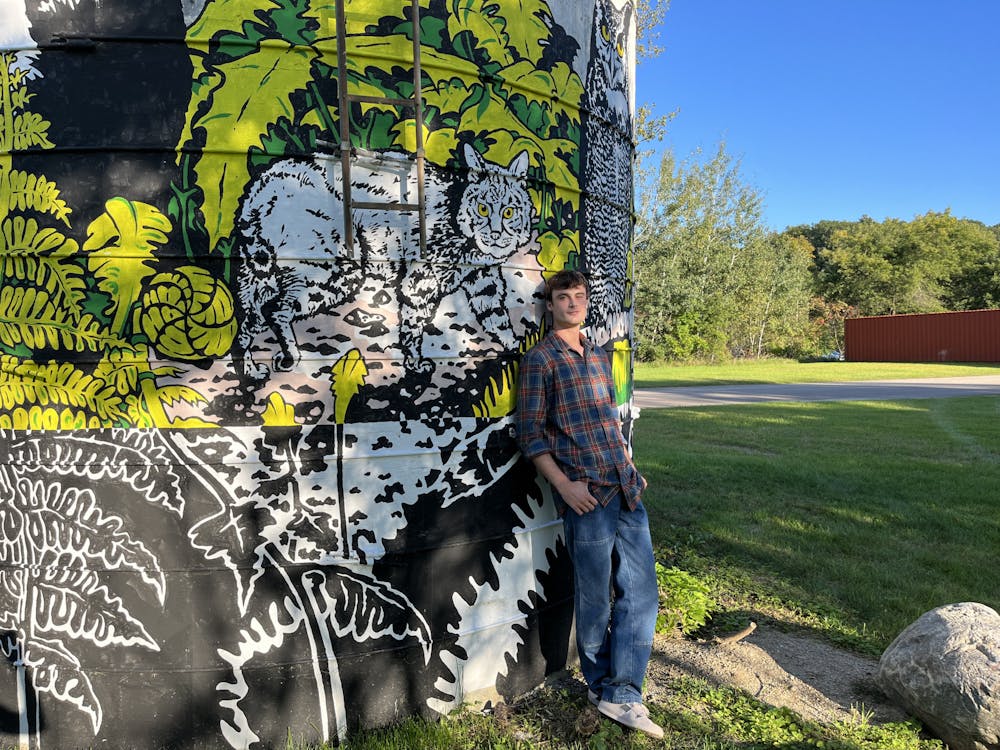This summer, an often overlooked corner of campus got a makeover. Amidst unpredictable weather and on an unconventional canvas, architecture major Wyatt Robinson ’24 successfully completed a vibrant mural encircling the silo outside the Recycling Center. The mural is one of the latest additions to Middlebury’s outdoor art collection and is sure to become a community favorite.
Sponsored by the Middlebury College Innovation Hub, the project began way-back in the summer of 2022. Impressed by the Bridge School elementary school’s new silo mural, Middlebury Language School alumna Cookie Tager decided to sponsor another project of the sort in the area; this time, with the help of Middlebury students. She brought the idea to the attention of the Innovation Hub.
Tager’s vision first came to life when Shane Silverman ’24.5 began preparing the logistics in summer 2022 while interning for the Vermont Creative Network. Silverman first conducted a feasibility study for the Silo Transformation Project before creating a baseline for the location and timeline of the potential mural.
An artist in his free time, Robinson answered the call of an April announcement on behalf of the Innovation Hub that the department was in search of a student artist to pursue the summer painting phase of the project. Robinson was ultimately selected for his impressive attention to detail and robust project proposal, according to Silverman.
Now, five months after that initial email, Robinson’s mural capturing a vibrant, almost psychedelic interpretation of Vermont flora and fauna decorates the Silo’s surface. Electric greens and yellows fill in black-outlined ferns and flowers, while splotches of white represent the forms of a bobcat, an owl and other animals. Massive raindrop-shaped splotches of blue mimic the splashing of a fish, which can be seen leaping beyond the top edge of the mural.
“The bobcat and the area surrounding the bobcat’s face [are] my favorite [part] of the whole thing. I just like the color palette — this pinky gray. It's really simple, but adds a lot of depth,” Robinson said.
He also admired the abstract ripples that fill parts of the mural without any plant or animal subject matter. The ripples create a feeling of movement on what is otherwise a rigid surface, Robinson said. As he filled more and more of his metal, cylindrical canvas with creatures and waves, his painting process evolved.
“At a certain point, I stopped using my reference. I just felt so comfortable with what I'd been doing that I could kind of keep the exact same aesthetic, more just on the fly without having to cross-reference every line I was making,” Robinson said.
While Robinson raved about the creative process, the project did not come without its challenges. Operating amidst drastic flooding this summer, Robinson had no choice but to work around nature’s schedule to avoid paint running in the rain.
“I had to be more connected to my environment than I think I had ever been before,” Robinson said. “There was one day when I was doing the moose, I packed up and ended up returning on three separate occasions because I was kind of listening to the clouds, feeling the pressure.”
Getting the final finishing touches onto the surface also proved challenging. Robinson described feeling a lack of motivation towards the end of his painting process, but seeing people come and visit his mural ultimately reinvigorated his dedication to the project. Robinson recalled one particular group of visitors that fueled his finale.
“One day I came down, there were a bunch of little kids running in circles around it,” Robinson said.
He recalled fielding questions such as, “Why do all the animals have yellow eyes? Except for the bear?” Robinson explained that their energetic curiosity spurred him back into action, motivating him to complete the project.
“It was maybe the most fulfilling thing I've done. It was an amazing experience,” Robinson added.




